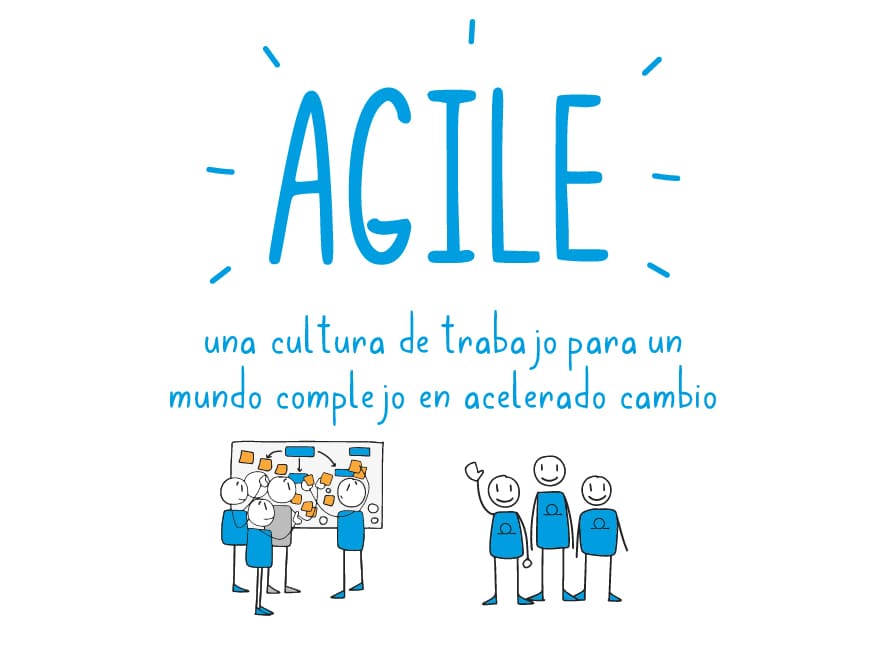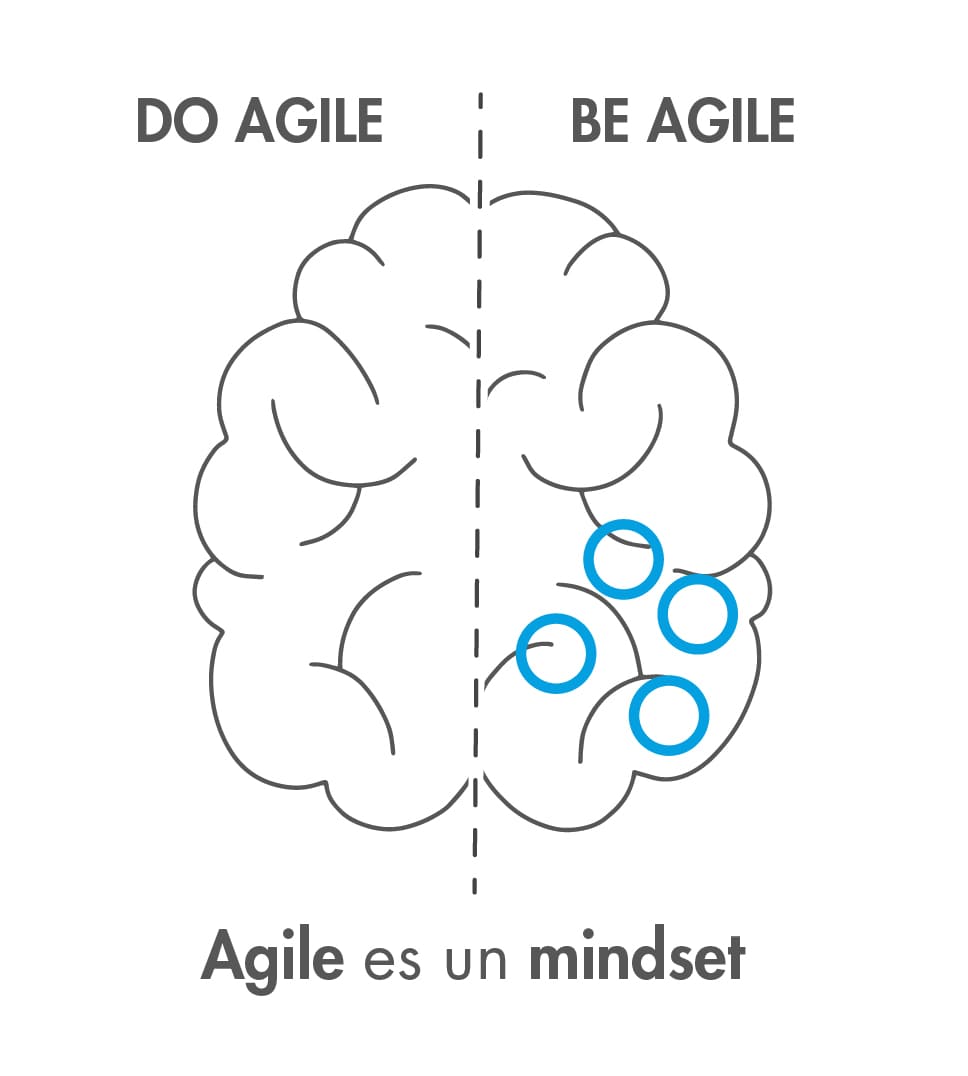What is agility, definitions and concepts to lay the groundwork
Belen Oller
- Agile Coaching
- Article
To address the answer to the question of what agility is, we can start by saying that agility is a mindset, a way of approaching challenges, defined by 4 values and 12 principles. These principles and values are found in Manfiesto Agile.
Also, we can define agility as “a work culture for a complex world in rapid change”.

If we analyze this last sentence, we can see that, by definition, culture is a collective way of thinking and acting. Therefore, following this line, agility is a concrete proposal of how to think and act in the face of the challenges we face in today’s world. A world that is, above all, volatile, uncertain, ambiguous and complex (you can read more about VUCA characteristics in this article).
One of the most relevant characteristics of this “way of thinking and acting” is that it has to help us to respond to the emerging, to the new, to change, to the unexpected. It must help us to adapt quickly to new business models, to new competitors, to crises.
In short, agility must help us to be able to adapt quickly to changes.
But, how to deal with the unknown and the new if we do not have, in many cases, previous experience, given that we are all facing new contexts at the same time? Well, agility helps us to manage uncertainty by approaching it from an empirical point of view.
Doing and being agile
It is very popular to hear that it is not only about “doing” agility, i.e. employing certain frameworks and/or techniques, but also about “being” agile, i.e. that our actions, our way of behaving reflect the values and principles of agility. But, in the end, if we really have an agile mindset, the rest will follow.
One thought that is always good to come back to is that agility is a means to an end. This means that agility can never be the end in itself. The means describes how to do things. The end is why or what we do things for. The problem with focusing on the means rather than the end is that the same means do not necessarily lead to the same results. For example, training in the same way as an elite athlete does does not guarantee that you will have the same results.
Focusing on the end creates flexibility. Focusing on the means may create limitations.
Focusing on understanding what value is for the customer, on how to get to market faster, on knowing how to respond to changes is focusing on the end. On the other hand, focusing on whether we do Scrum or Kanban, whether the sprint has to last 2 or 3 weeks, or which software is better to use to manage the work, is focusing on the means, and can make us lose focus, speed and opportunities.
Therefore, there is no need to change the means into goals: implementing agile frameworks should not be the end of an organization. Organizations should first ask themselves: Why do they want to be agile? What are the challenges they face? And, from there, reflect on whether an agile culture can be the means to that end.
Whatever challenges the organization is facing, the reflection will always be the same: Agile is not the why. Agile is the how: How to maximize value delivery.
Agility characteristics
There are certain characteristics that must be present when working under an agile mindset. In the following, there are a number of characteristics that will help us to identify if we are working in line with what agility proposes:
The customer is always at the center of the decision making process
When we talk about agility, we talk about discovering and, therefore, learning how to maximize the delivery of value to the customer. When we have a mindset that embodies the values of agility, we always put the customer first. The customer has to be at the center of all decisions. If we are agile, we understand that, as the first principle of the Agile Manfiesto says, “Our highest priority is to satisfy the customer through early and continuous delivery of software with value“
We aim to maximize value delivery
Already in the first principle of the Agile Manfiesto, another of the keys to agility appears: value. Everything we do must be oriented to deliver value. Paraphrasing and taking it to the extreme, we could say that “if there is no value, let there be nothing“. The complexity of delivering value lies in the fact that value is subjective; not all people value the same thing.
We embrace change and adapt to it rapidly
When we have an agile mindset, we understand that changes will always be present and we understand them as an opportunity to “provide a competitive advantage to the customer” (second principle).
From here, we work with defined and stable processes that allow us to adopt those changes as quickly as possible. Agility is adaptation.
Working iteratively and incrementally
One way to respond rapidly to change is to work iteratively, reducing execution times, increasing its adaptability and predictability, while working incrementally, that is, we deliver a sufficiently good part of the solution in each iteration so that we increase the final solution.
In this article you will find an example of how to maximize learning through short iterations.
Always seeking continuous improvement
Each iteration has the purpose of delivering value while learning what value is. We have to ask questions and get to know our customers so that from there we can learn, adapt, change and continuously improve. In each iteration we inspect the work to learn something new we didn’t know that allows us to adapt course, change and improve.

Reflections that can help us not to lose focus…
Here are some clarifications and points to reinforce on agility that can help us not to lose focus:
Agility does not solve problems:
It brings problems to the surface as soon as possible. That is why transparency is one of the key pillars.
Agility is an emerging practice:
It emerges from finding ourselves in complex environments in which we do not know the cause-effect relationship. As we do not know the environment in which we move, we have to test what works and what does not, to discover it.
Agile practices are based on empirical knowledge:
Let’s learn by doing. Let’s make hypotheses and validate them. Sometimes we are going to get it right and sometimes we are going to fail. That’s why the phrase “Fail cheap, fail fast” because since we are going to fail, and we know it, we want to do it fast to learn fast.
Agile frameworks are not value guaranteeing:
Whether you apply scrum or any other framework does not guarantee value delivery.
In agility the focus is on people, basically because we are the people who do the work. A job that is more challenging every day and that requires us to be continuously learning #alwayslearning.
Therefore, values such as communication, collaboration, trust and motivation have taken center stage as one of the most important factors to take into account so that everything that agility proposes materializes. This is reflected in the fifth principle of the Agile Manfiesto: “Projects are developed around motivated individuals. They must be given the environment and support they need, and they must be entrusted with the execution of the work“